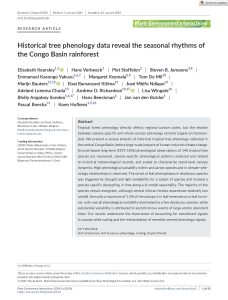
Kearsley E., Verbeeck H., Stoffelen P., Janssens S. B., Yakusu E. K., Kosmala M., De Mil T., Bauters M., Kitima E. R., Ndiapo J. M., Chuda A. L., Richardson A. D., Wingate L., Ilondea B. A., Beeckman H., van den Bulcke J., Boeckx P., Hufkens K. [2024 ] Historical tree phenology data reveal the seasonal rhythms of the Congo Basin rainforest. Plant-Environment Interactions, 5, e10136. https://doi.org/10.1002/pei3.10136
Abstract :
Tropical forest phenology directly affects regional carbon cycles, but the relation between species-specific and whole-canopy phenology remains largely uncharacterized. We present a unique analysis of historical tropical tree phenology collected in the central Congo Basin, before large-scale impacts of human-induced climate change. Ground-based long-term (1937-1956) phenological observations of 140 tropical tree species are recovered, species-specific phenological patterns analyzed and related to historical meteorological records, and scaled to characterize stand-level canopy dynamics. High phenological variability within and across species and in climate-phenology relationships is observed. The onset of leaf phenophases in deciduous species was triggered by drought and light availability for a subset of species and showed a species-specific decoupling in time along a bi-modal seasonality. The majority of the species remain evergreen, although central African forests experience relatively low rainfall. Annually a maximum of 1.5% of the canopy is in leaf senescence or leaf turnover, with overall phenological variability dominated by a few deciduous species, while substantial variability is attributed to asynchronous events of large and/or abundant trees. Our results underscore the importance of accounting for constituent signals in canopy-wide scaling and the interpretation of remotely sensed phenology signals.
Consultez la notice complète de l’article sur ORBi
